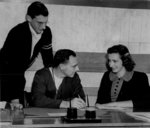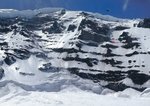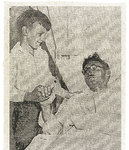


Last campfires never die,
And you and I on separate trails to life’s December,
Will always dream by this last fire,
And have this mountain to remember
— Clark Schurman
Leon Brigham Jr. wanted his friend to take the other end of his ice ax. Just as a precaution, just to be sure.
Fear didn’t register with Brigham, whom everyone called Juney. Great athlete. Easy sense of humor. Blossoming climber. In that moment, Juney was 21 and invincible.
It was a beautiful afternoon on Mount Rainier. More cars visited the national park on that day, Aug. 10, 1941, than ever before. Juney and four friends had spent the day hiking and climbing at lower elevations. They took pictures and ate lunch on a bench. Then they started down.
None of them knew that their decisions that afternoon would ripple across three generations and 75 years, adding another reminder that for all its charms and grace, Mount Rainier is ultimately unforgiving.
Juney, the most experienced climber, led the way down. In a week, he intended to follow his father’s footsteps and summit Mount Rainier. But if his dad’s climbing history had inspired his love of the mountain, it also was reason to respect it. Maybe even fear it.
The group stopped. A crevasse, dark and bottomless, blocked their descent. But Juney saw a solution: A small snow bridge stretched the gap.
He extended the handle of the ice ax to one of his best friends, a 20-year-old classmate at the University of Washington named Harrison Holland. Juney clutched the pronged end. And then he took a step.
Juney’s father, Leon Brigham Sr., fell in love with the mountain in the 1920s, when everyone else was debating what to call it.
Some natives had known it as Tacoma, or Tahoma. Others had referred to it as Tacobet. Still others had called it the Mountain That Was God.
Mount Rainier is the name that appeared on maps and in conversation, the name British explorer George Vancouver gave the peak in 1792. Admiring the mountain’s beauty from his ship, Vancouver named it after a friend who fought for the British in the Revolutionary War.
For years, Mount Rainier had no official height. Nor had anyone officially summited the mountain until 1870, setting off a rush of explorers, thrill-seekers and adventurers — all the personalities drawn to Mount Rainier’s permanent challenge, its dominance in the sky.
By the 20th century, Mount Rainier held important commercial appeal for the region. A 14,000-foot advertisement. The City of Tacoma suggested an opportunistic yet futile name change: Mount Tacoma. Seattle swiftly rejected the proposal.
In 1921, when Leon Brigham Sr. moved from Iowa to Seattle, the mountain was more accessible than ever. Mount Rainier National Park opened in 1899, and with it roads and infrastructure.
From the beginning, Mount Rainier was ruthless and generous, sometimes in the same day. About 10,000 people attempt to climb the mountain each year. The first recorded death was in 1897, two years before the park opened, and more than 100 have died since. It is one of the most dangerous active volcanoes in the country, yet its immediate dangers are far more intimate: a falling boulder, a blizzard, a crevasse.
In the summers, Brigham served as a summit guide, leading curious tourists, teachers and even prominent out-of-town businessmen up the mountain’s slopes.
In the fall, he coached football at Garfield High School. He also coached basketball in the winter and track in the spring and won championships in all three sports. Local writers called him the “Fox.” He had a reputation for assessing talent, strengths and weakness, and adapting his strategy. Young boys dreamed of playing for him, including his son Juney, and the field at Memorial Stadium still bears his name.
A perfectionist, he demanded the same from his players, his children and himself. It’s what made him a respected guide, and he summited the mountain nearly 50 times without incident. Until everything changed in 1929.
LEON BRIGHAM SR. is in a crevasse and assessing the damage. Who is alive? How bad is it? Brigham is in charge of this six-man climbing party. He did half of his job; he got the group to the summit — the first summit attempt of 1929. But the job isn’t complete until he gets them back down, until he gets them home.
The trouble started 1,000 feet from the summit. A blizzard overtook the mountain. Snow. Wind. Tiny ice particles. Brigham chopped steps in the snow-covered ice and told everyone to follow his footsteps because they could barely see. None of them wore crampons.
Edwin Wetzel, an attorney from Milwaukee, had been so exhausted near the summit that Brigham physically coaxed him to the top. As Brigham searched for a way across a crevasse on their descent, he heard a noise: Wetzel had slipped on the ice. His weight yanked the rope tying each of them together and dragged them all with him. They rolled and bounced off the edges of the crevasse, finally stopping once they hit bottom 75 feet down.
Brigham looked around. One man had landed on a ledge above him. One was pinned by a chunk of ice. Wetzel was badly injured. Another man, a high-school football coach named Forrest Greathouse, lay unconscious. Each man in the crevasse understood his only choice: survival.
The man on the ledge climbed out and headed for help. Brigham and another climber, Yancey Bradshaw, hacked free the man trapped by ice. An hour later, they climbed out of the crevasse. They left the food and rope behind.
For long stretches, Brigham and Bradshaw crawled or slid. Exhaustion set in. Unable to go any farther, they passed out, then pleaded with each other to keep going, to take just a few more steps. It took them nine hours to reach the safety of Camp Muir.
Wetzel somehow made it out of the crevasse but died in the blizzard trying to find his way down the mountain. Greathouse never regained consciousness. Rescue parties chopped his frozen body out of a block of ice four days later. The accident led to new regulations requiring climbers to wear crampons, and Brigham received praise from his fellow climbers.
Brigham directed the search parties of both dead men from his bed. Five cracked ribs, skin savaged by the cold, his senses rattled by shock and trauma. His children set off fireworks in the backyard, hoping to cheer him up. Newspapers took his picture and asked questions. In one of the pictures, a 9-year-old boy gently holds Brigham’s right hand, staring lovingly from the side of his father’s bed — Juney.
THE SILENCE IS HAUNTING. When someone disappears into a crevasse, Mount Rainier consumes not only the body but also the noise. A vacuum. The person is there one step, gone the next. In those first few seconds, as the brain processes what has happened, there is only silence. No screaming, no clattering of debris, no thud. Just nothingness.
It never lasts long. Soon there is plenty of noise. It bounces off the ice, wails into thin air, begs for an answer: the desperate screams of a person pleading for the vanished to respond.
EVEN AS AN old man, Leon Brigham Sr. remembered the football game. 1938. A crowd of 10,000 at Civic Field. Garfield vs. Roosevelt.
Coaches didn’t call plays then, so they had to rely on a player on the field. That player was Juney. Juney got bigger and stronger as he got older, but his greatest asset was always his mind.
He also ran track for his dad and played on his father’s basketball team. As a Christmas gift one year, his dad bought Juney and his older sister complete ski outfits with one condition: Juney couldn’t start until after basketball season.
Juney and his three siblings grew up on Mount Rainier. As they hiked, their father sang his favorite song, “Home on the Range,” in his beautiful baritone voice. In the summer, they camped by the ocean or on the mountain. All the Brigham children learned to love Mount Rainier, but Juney was captivated by it. Something stirred inside him.
It was easy to see his future forming: skiing in the winter, climbing in the summer, coaching in the fall. Just like his dad.
With a minute left in the game against Roosevelt in 1938, Juney called the play. He sprinted down the field and sliced behind the defense. A pass floated high in the end zone. He leapt over two defenders, grabbed the ball, held on. Touchdown. Game over.
The greatest game Leon Brigham Sr. ever coached.
THE DAY AFTER Juney’s death, Harrison Holland sat in his boyhood home, staring out the window, his eyes restless and hollow. His mother sat nearby. This was the first time she had heard what happened.
The snow bridge collapsed right away. Juney went with it. So did the ice ax. The handle snapped out of Holland’s fingers.
Harrison looked into the crevasse, unable to see the bottom, unable to understand what had just happened. He didn’t hear anything. Juney had just vanished.
Harrison and his friends started screaming, as loud as they could, as long as they could. They shouted until they couldn’t shout anymore. They tied one of their friends to a rope and lowered him into the crevasse, but soon realized that if he went any deeper, they might not get him out.
Harrison and another friend turned back for help. On the way down, Harrison took a wrong turn. By the time he reached camp, exhausted and in shock, park rangers wouldn’t let him go back up.
Back in Seattle, Juney’s family was loading up the car. They had planned to meet Juney on the mountain and were packing camping gear. Then the phone rang.
Juney’s younger sister, Diane, and younger brother, Charles, were outside when they heard their mother scream. Leon Brigham Sr. unpacked the car, leaving everything in front of the house. Charles rode with him, his dad pounding the steering wheel as he drove.
That night, Leon Brigham Sr. joined rescue crews searching for his son’s body. They reached Juney the next morning, buried under 8 feet of ice and snow, his shirt removed as hypothermia took hold. Harrison Holland told Leon Brigham Sr. about Juney’s death. It was one of the hardest things he ever had to do.
At Juney’s funeral, they sang “Home on the Range.” His father stayed for a long while afterward, staring into the casket.
CHARLES BRIGHAM idolized his older brother Juney.
Charles always wanted to climb Mount Rainier, but after Juney’s death, his parents wouldn’t hear of it. The Brighams didn’t camp or hike much anymore. The house was quieter, less fun. Juney’s sister, Diane, was 11 when her brother fell, and she marks his death as the end of her childhood.
In summer 1973, more than 30 years after the accident, Charles Brigham finally followed Juney’s lead: He summited Mount Rainier with his daughter. He swore he could hear Juney as he climbed.
The sun beat down that day, melting the snow and ice. As they headed down the mountain, Charles Brigham slipped. He tried to dig his ice ax into the ground, but the strap around his wrist broke. His daughter watched as her father disappeared into a crevasse, almost in slow motion.
Silence.
Horrified, she thought of her Uncle Juney and started screaming. That’s when she heard: “I’m fine; just get me out of here!” It was her father, responding from on top of an unstable chunk of ice.
After an hour or two, he climbed free. His wife waited nervously, wondering why her daughter and husband were taking so long. But neither Charles Brigham nor his daughter revealed what happened once they descended. It was their secret for more than 10 years.
HARRISON HOLLAND DIED just as he lived: dominant, commanding, in total control. When he lost use of his arms and legs in 2015 without hope of ever getting them back, he took charge once more.
A veteran of World War II, a professor, a writer, a diplomat and an international traveler fluent in Japanese, he had a fulfilling life. Rather than live as a quadriplegic, he stopped eating, and died on Jan. 29, 2015, at his home, just as he’d intended. He was 93.
Among his final wishes, he wanted half his ashes buried next to his wife, the other half spread on Mount Rainier. His children don’t remember their father hiking or showing much interest in the mountain. They knew about Juney, the ice ax and the accident in 1941. But they never asked their father for an explanation, and he never offered one.
They secured a permit through the national park, booked a small plane and watched out the window as his ashes scattered from a brown paper bag toward the top of the giant mountain.
SLOWLY, CAREFULLY, the group ascends Mount Rainier. It’s 1941. A crescent moon hangs in the sky, gently reflecting off the snow and ice. The summit looms in darkness. Juney’s death is 14 days old.
They reach the peak at 5:30 in the morning. They can stare for miles in any direction, but they aren’t here to admire nature’s beauty. They are here because of its power.
Worth McClure Jr., the son of the superintendent for Seattle schools, makes his way to Register Rock, more than 14,000 feet above sea level. He signs his name on a 4-by-6 card, identifying himself as the group’s leader.
The sunrise started just 14 minutes ago: a giant egg yolk spilling yellow glow and lighting up the clouds in pink, orange and red. From the summit, where McClure stands, the world looks like a painting.
He writes a second name and the purpose of this trip:
Leon Brigham Jr., age 21, ashes brought here.